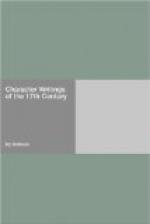[Footnote 42: The room where the performers dress, previous to coming on the stage.]
[Footnote 43: This passage affords a proof of what has been doubted, namely, that the theatres were not permitted to be open during Lent, in the reign of James I. The restriction was waived in the next reign, as we find from the puritanical Prynne:—“There are none so much addicted to stage-playes, but when they goe unto places where they cannot have them, or when, as they are suppressed by publike authority, (as in times of pestilence, and in Lent, till now of late) can well subsist without them,” &c. Histrio Mastix, 4to, Lond. 1633, page 384,]
[Footnote 44: It may not be known to those who are not accustomed to meet with old books in their original bindings, or of seeing public libraries of antiquity, that the volumes were formerly placed on the shelves with the leaves, not the back, in front; and that the two sides of the binding were joined together with neat silk or other strings, and, in some instances, where the books were of greater value and curiosity than common, even fastened with gold or silver chains.]
[Footnote 45: A hanger-on to noblemen, who are distinguished at the university by gold tassels to their caps; or in the language of the present day, a tuft-hunter.]
[Footnote 46: If he could order his intentions, first edit.]
[Footnote 47: Minshew calls a tobacconist fumi-vendulus, a smoak-seller.]
[Footnote 48: Cento, a composition formed by joining scraps from other authors.—Johnson. Camden, in his Remains, uses it in the same sense. “It is quilted, as it were, out of shreds of divers poets, such as scholars call a cento.”]
[Footnote 49: Firing, first edit.]
[Footnote 50: In the hope of discovering some account of the strange monster alluded to, I have looked through one of the largest and most curious collections of tracts, relating to the marvellous, perhaps in existence. That bequeathed to the Bodleian, by Robert Burton, the author of the Anatomy of Melancholy. Hitherto my researches have been unattended with success, as I have found only two tracts of this description relating to Germany, both of which are in prose, and neither giving any account of a monster.
1. A most true Relation of a very dreadfull Earthquake, with the lamentable Effectes thereof, which began upon the 8 of December 1612, and yet continueth most fearefull in Munster in Germanie. Reade and Tremble. Translated out of Dutch, by Charles Demetrius, Publike Notarie in London, and printed at Rotterdame, in Holland, at the Signe of the White Gray-hound. (Date cut off. Twenty-six pages, 4to, with a woodcut.)
2: Miraculous Newes from the Cittie of Holt, in the Lordship of Munster, in Germany, the twentieth of September last past, 1616, where there were plainly beheld three dead bodyes rise out of their Graves admonishing the people of Judgements to come. Faithfully translated (&c. &c.) London, Printed for John Barnes, dwelling in Hosie Lane neere Smithfield, 1616. (4to, twenty pages, woodcut.)]




